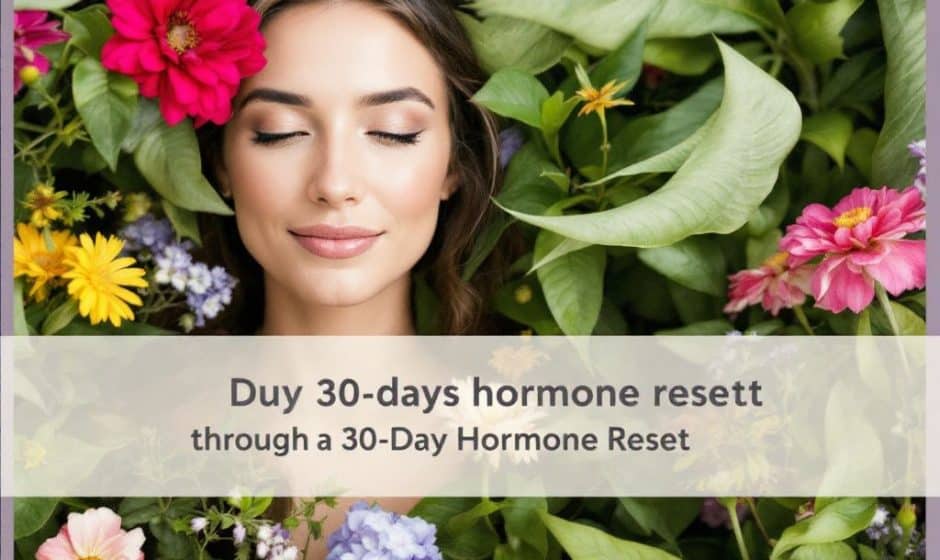Why does feeling out of sync seem so normal these days? It’s like you’re always running against the wind, caught in a whirlwind of fatigue, mood swings, and that nagging sense that something’s just… off. Trust me, I’ve been there. And guess what? The root cause often traces back to our hormones being out of balance. Yeah, those little chemical messengers are so crucial yet somehow always flying under the radar.
Understanding the Hormone Balancing Diet
Let’s talk about the backbone of your 30-day journey: the **hormone balancing diet**. It’s all about harmony, my friend! That kind of symphony where your insulin, cortisol, estrogen, and friends are all on the same page. Think of this like trying to get a rock band to gel—different instruments but one amazing output when done right.
Here’s a truth-bomb: our everyday food choices can either play the role of a supporting character or, frankly, the villain in our hormonal chaos. Glancing over our meal choices, we might say, “Eh, it’s just food,” but the reality is, what we eat dictates a whole lot about how our hormones run the show.
Step 1: Clearing the Slate – Detox the Mind and Plate
Before diving into the nitty-gritty of meal plans and recipes, we have to start by decluttering—both mentally and physically (yup, your plate too). Here’s what to focus on:
- Eliminate Processed Foods: Time to ditch the refined sugar and unhealthy fats. Give this a try and see how your energy levels perk up.
- Hydration: Ever underestimated the power of water? Keeping hydrated helps your body flush out toxins—critical when resetting your hormones.
- Mindfulness Practices: Stress is a hormone’s worst enemy. I mean cortisol just goes bananas in a storm of stress. Consider meditation or just a few minutes of quiet time. You’ll thank yourself later.
Step 2: Building a Hormone-Friendly Plate

Alright, we’ve ditched the ‘no-good’ stuff, so what now? Here’s how to make every plate you fill an object of hormonal joy:
Essential Nutrients to Include
- Healthy Fats:
- Examples: Avocados, nuts, chia seeds, olive oil
- Benefit: They support healthy cell membranes and hormone production—not to mention keeping you full and satisfied.
- Lean Proteins:
- Examples: Salmon, chicken, legumes
- Benefit: These stabilize blood sugar and boost metabolism (Hello, Energy!).
- Colorful Vegetables:
- Examples: Broccoli, spinach, bell peppers
- Benefit: Packed with fiber and antioxidants, veggies support detoxification and gut health—a huge component in hormone function.
Avoid These Hormonal Disruptors

- Refined Carbs and Sugars: Cakes, white bread, soda—it’s like pouring oil on a fire.
- Excessive Caffeine: Coffee lovers, this one’s hard, but moderation is key. Try switching it up with herbal teas.
Step 3: Committing to Consistent Meal Timings
You’re pulling through with the right food choices—but what about when you eat? Regular meal times anchor hormone balances, similar to how routine feeds productivity at work.
- Start with a Solid Breakfast: Set the tone (and blood sugar levels) right from the get-go. Oats with berries or a veggie omelette can work wonders.
- Stable Eating Patterns: Opt for three meals a day and mindfully enjoy them, keeping at least one or two snacks in between if necessary.
Step 4: Fitness: More Movement, Less Grind
Adding exercise into this mix is like giving your hormones a best friend. But don’t overthink it—exercising hard doesn’t mean working out hours daily.
- Balance is Key: Mix up yoga, light weights, and a walk in nature. Excessive cardio can actually make cortisol levels skyrocket.
Step 5: Snooze Like You Mean It

Sleep, a non-negotiable aspect we’re all so guilty of underestimating. Stick to 7-9 hours. A cozy bedtime could mean waking up refreshed and with a powerhouse set of balanced hormones.
Tracking Your Progress: The Health Reset Plan
Alright, as much as we’d love to believe the will is enough, keeping track of our journey is what grounds us. Make it fun and less like you’re back in school. Grab a journal and jot down how you feel daily: Energy levels? Mood swings? Sleep quality? Sometimes the best motivation is seeing your progress right before your eyes.
Celebrate the Small Wins
Feel a bit more energetic rolling out of bed? Mood swings less dramatic? These initial changes might be small but celebrating them reinforces why you started this reset journey in the first place.
The Wrap-Up: Your Balanced Life Awaits
So here’s the gig, folks. It’s not a quick sprint; think of it as reshaping your health Bluetooth network—a system where every element ties back to the greater mission of feeling fantastic. Your hormones, when reset, can create this newfound wave of energy, emotional balance, and, most importantly, control over your own well-being.
Give it the 30 days. Challenge assumptions, try new recipes, include relaxation into your daily grind, and observe how it all fits into a wider, wonderful picture of well-being. You’ll thank yourself big time ten years down the line for choosing a path anchored in informed choices and balanced lifestyles. Now, go on and conquer those 30 days—you’ve got this!
Frequently Asked Questions
What is a hormone balancing diet?
A hormone balancing diet is a dietary approach designed to support and balance the body’s hormonal system. It typically includes foods that are rich in healthy fats, anti-inflammatory ingredients, cruciferous vegetables, high-quality proteins, and slow-burn carbohydrates. This diet aims to optimize metabolic functions, reduce inflammation, and support overall hormone health[2][3][5).
What foods should I include in a hormone balancing diet?
Foods that support hormone balance include avocados, fatty fish like salmon, cruciferous vegetables such as broccoli and Brussels sprouts, whole grains like quinoa and brown rice, and healthy fats like olive oil and nuts. Additionally, incorporating foods rich in fiber, magnesium, and omega-3 fatty acids can help stabilize hormones and reduce inflammation[3][4][5).
How can a hormone balancing diet improve my health?
A hormone balancing diet can enhance metabolic efficiency, improve mood and energy levels, reduce the risk of chronic diseases like type 2 diabetes and certain cancers, and support reproductive health. It also helps in maintaining healthy skin and optimizing the body’s overall physiological processes[2][3][5).
What lifestyle changes are recommended alongside a hormone balancing diet?
In addition to dietary changes, lifestyle adjustments such as minimizing caffeine and alcohol, avoiding processed foods, and incorporating regular meals every 3-4 hours can support hormone balance. Also, considering supplements and a 2-week detox phase, as suggested in some plans, can be beneficial[1][2][5).
References



